One of the most popular greenhouse crops grown in central Russia are cucumbers. Planting and caring for the cucumbers in the greenhouse require a certain amount of time, labor and knowledge of technology. What are the best greenhouse varieties? How to prepare a greenhouse and beds? When to plant cucumbers and how to care for them? How to protect from diseases? We will talk about all this and much more in this review.
Material Content:
- 1 Cucumbers - varieties for the greenhouse
- 2 Preparing a greenhouse for cucumbers
- 3 Features of growing from seeds
- 4 Planting cucumbers in a polycarbonate greenhouse
- 5 Greenhouse care
- 6 The main problems associated with growing
- 7 Diseases, pests and methods of dealing with them
- 8 How to prepare a greenhouse for winter?
Cucumbers - varieties for the greenhouse
Of all the factors that influence success, a variety is of maximum importance. For indoor use, self-pollinated cucumber varieties for greenhouses are better suited.
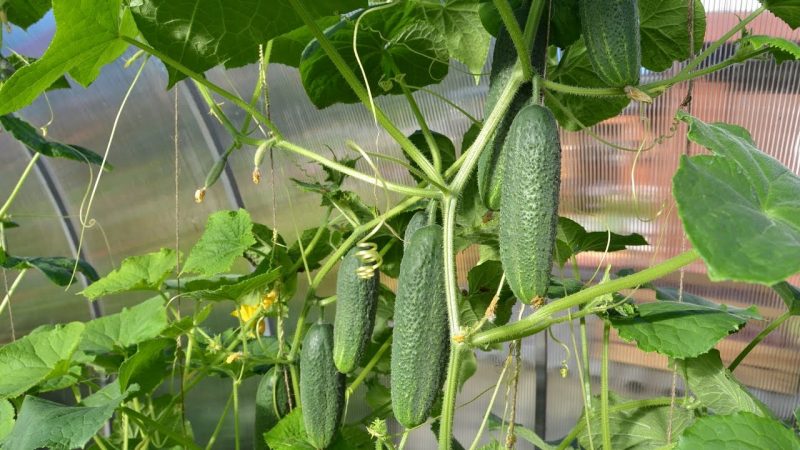
Let us dwell on some of them.
- F1 Ant - super-early variety, resistant to disease, giving a harvest in 37-40 days.
- F1 Buyan is an early ripe hybrid that can withstand extremes of temperature and humidity.
- F1 Goosebump - an early hybrid that is immune to powdery mildew.
- F1 Zozulya is an early ripe variety that does not require careful trimming due to branch self-regulation.
- F1 Benefit is a mid-season hybrid resistant to many diseases.
- F1 Emelya is a cold-resistant mid-season variety with high productivity.
- F1 April - an early ripe frost-resistant hybrid.
Preparing a greenhouse for cucumbers
The market offers a wide range of ready-made greenhouses made of polycarbonate. You can take any, based only on the planned areas of future plantations. It is only important to ensure that the possibility of ventilation is provided in the greenhouse.If hot summer weather is often set in your area in summer, then you should think about artificially creating an air flow with the help of fans. Therefore, choose a greenhouse where it is possible to place such a plant.
If you wish, you can build a greenhouse with your own hands. The best material for the frame is steel bars, but they are expensive. An option that is not much inferior to the previous one in reliability, but much cheaper, is polypropylene pipes.
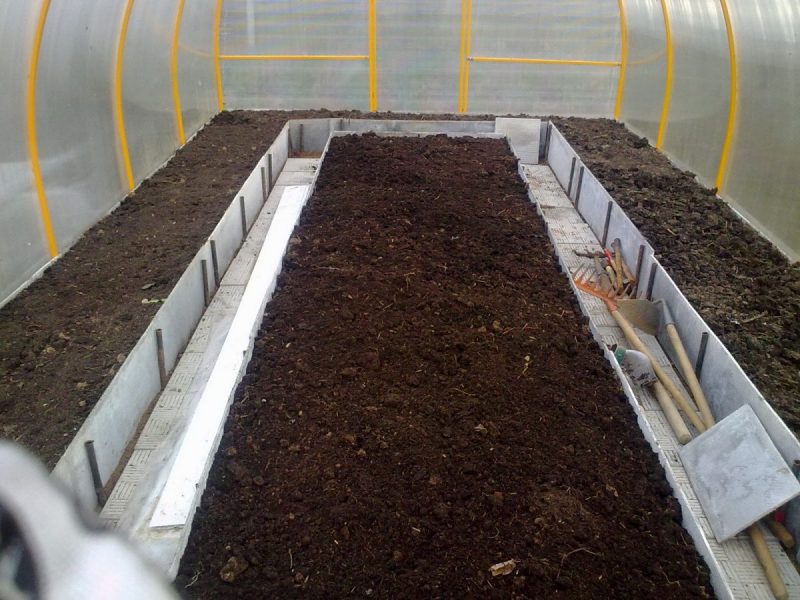
The cheapest covering material is a plastic film. It has two drawbacks: it retains heat slightly worse than other materials, and is less durable. Usually it requires replacement in a year.
You can cover the greenhouse with glass, which, however, can be damaged by hail. If you are lucky and during the entire existence of the greenhouse the hail never falls out, then the glass will be the most durable material.
And the most popular shelter is considered to be polycarbonate. It retains heat well, is more durable than polyethylene, and slightly inferior to glass. For these reasons, polycarbonate greenhouses are used almost everywhere. Depending on the quality of the product, this material can last an average of 5-7 seasons.
Regardless of the size of the greenhouse, the preparation of space for the cultivation of cucumbers is the same: from the roof to the ground, ropes are vertically stretched, around which the stems of the plants will be wrapped.
Features of growing from seeds
If, when growing cucumbers in open ground, seeds for seedlings are sown in late March or early April, then greenhouse varieties are sown in late February or early March. To do this, use containers with light, crumbly soil. If you wish, you can purchase special soil for seedlings, which, however, is recommended to be mixed with ordinary garden soil in a one to one ratio.
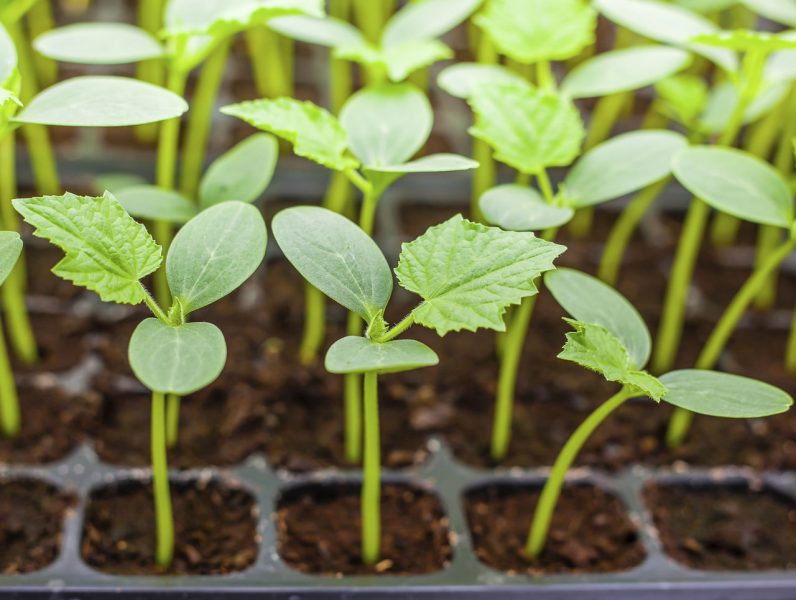
Keep the boxes in a warm room until the first shoots. After 2 weeks, the first sprouts hatch. Immediately after this, the containers should be placed in a well-lit room with an air temperature of 22-25 degrees. It is permissible to lower night temperatures to +16.
If long periods with cloudy days are established in early March, then the seedlings need to be illuminated with powerful sodium lamps DNAT, DNAZ or phyto-lamps. The light of ordinary fluorescent lamps for seedlings is too low.
3-4 weeks after germination, the seedlings are ready for planting in the greenhouse.
Planting cucumbers in a polycarbonate greenhouse
The best solution for greenhouse cucumbers would be to plant them on the so-called warm beds. What are they like? These are beds with a high content of decaying organic residues. Due to the decomposition processes occurring in their bowels, the soil temperature rises markedly and can reach +40 degrees. In practice, manure, compost, tops, tree branches and thick branches are used for laying ridges.
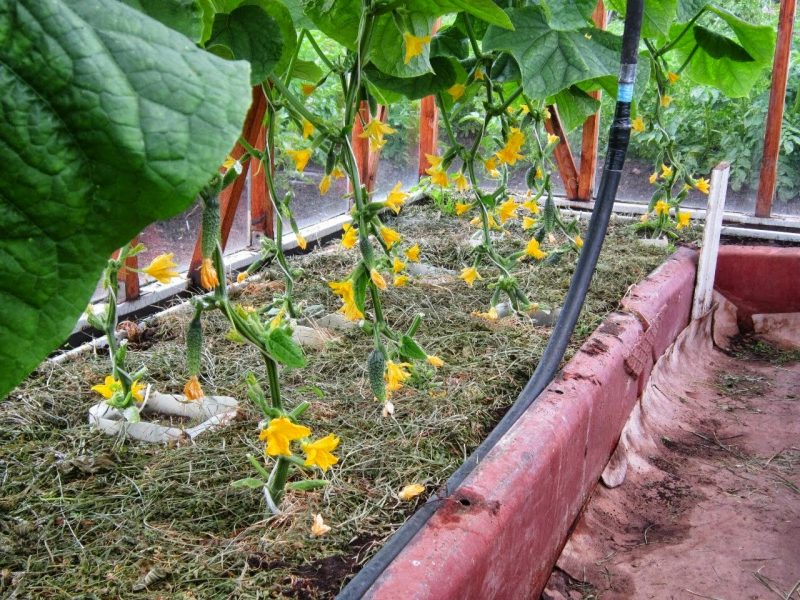
The most tangible result is the mixing of the soil in a ratio of one to one with manure-compost substance. These works are best done 1-1.5 months before transplanting.
Manure can be used horse or cow. It is mixed with compost, preferably in approximately equal proportions, placed on the surface of the soil and dug to the depth of a bayonet shovel. After laying the beds, it is watered lightly and covered with straw, leaves or a plastic film. In such conditions, manure burns out as quickly and efficiently as possible. This, by the way, is a good way to save on heating the greenhouse: the air is heated from the ground. When the temperature of the soil drops to 30 degrees, you can begin to plant cucumbers on the beds.
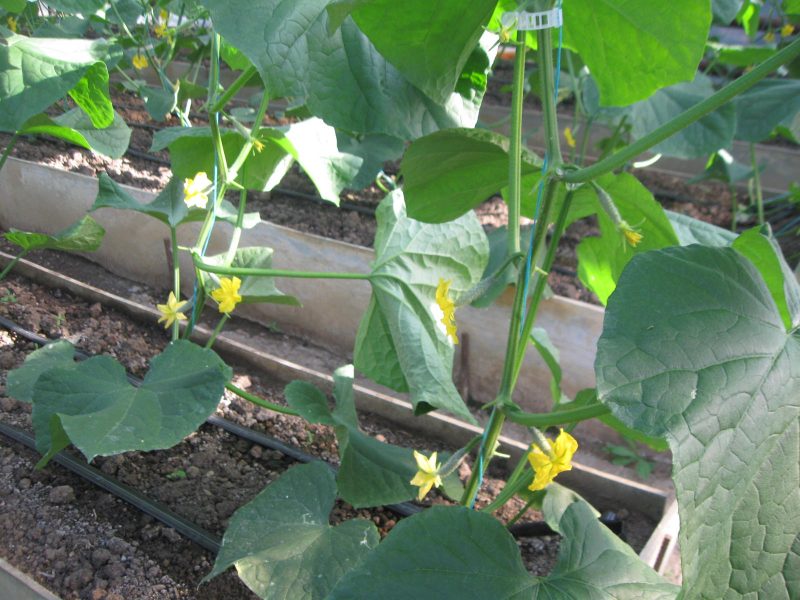
Another option is to lay organic residues at the bottom of the beds. With this method, you should not expect such a powerful effect as with the previous one. But it is cheaper, more affordable and more durable, since the leaves, branches and tops decompose longer and can produce heat for up to three years.
With this option, trenches are excavated along the width and length of future beds. Depth - 30-50 cm. Thick logs, boards, branches, leaves of trees, tops, ripe apples, food waste, straw and any other organics are laid at the bottom at half height. Heavier and more durable materials - boards and branches - are placed lower, sprinkled with a thin layer of earth, and the rest is laid on top. Before you fill the trenches with soil, you can pour them with special tools that accelerate the decomposition of organics.
Mineral fertilizers can be added to the topsoil: ammonium nitrate - 30 grams per square meter, superphosphate - 100 grams, potassium sulfate - 35-40 grams. You can sow cucumbers on beds immediately. The soil temperature in 2-3 months due to the processes taking place in the depths will rise by 2-4 degrees. This is enough for the cucumbers to respond in the form of active growth and abundant fruiting.
The distance between the plants can withstand about 25-30 cm, and the spaces between the rows are 40-50 cm. It is recommended to cover the planting with a plastic film. In the greenhouse, you can additionally save the heat generated by the warm bed, which is especially important if the temperature in the greenhouse itself still does not reach +20.
Greenhouse care
With the onset of heat, the film from the landings can be removed. In the future, it is important to monitor the temperature in the greenhouse: during the day it should not fall below +20 and rise above +30. If necessary, include an artificial hood that provides air movement. On hot July days, you can maximize the opening of the greenhouse in the morning and close in the evening.
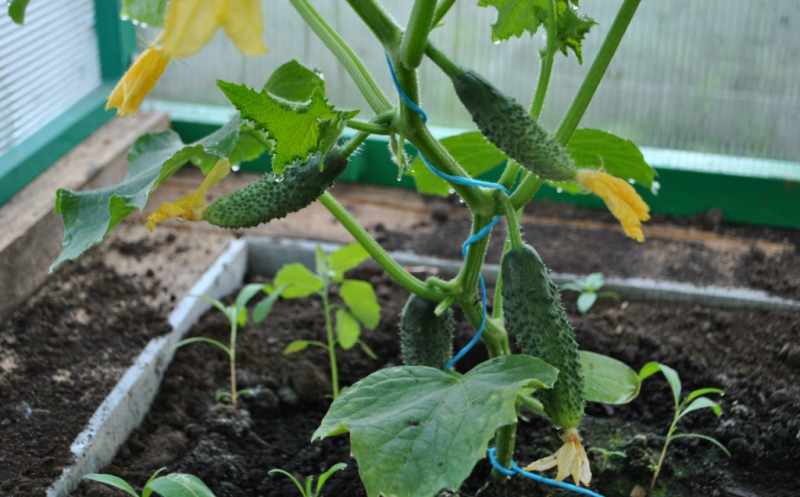
If warm beds were laid using manure, then fertilizing cucumbers is not required. In other cases, they are fed 3-4 times during the whole season. It is important not to overfeed, since excess substances is harmful to them.
During the flowering period, it is recommended to introduce tinctures of cow manure. In a slurry, you can add 1 spoon of nitrophoska and several tablespoons of ash for every 10 liters. Also, ash can be strewed onto the soil surface between plants. If it is not possible to prepare organic fertilizer, then you can pour cucumbers with a solution: 20 grams of superphosphate, 15 grams of potassium sulfate, 10 grams of urea are added for every 10 liters of water.
For the second top dressing, the solution can be formulated in the same way and irrigated when mass formation of the ovaries begins.
The third time fertilizers are introduced in the midst of fruiting. This time, all three types of granules fall asleep - urea, superphosphate and potassium sulfate - 15-20 grams each.
It is important to properly form the stem of the plant. The lower lateral shoots are completely removed, and the upper ones (from the middle and further) are nipped at the level of 2-4 leaves. At the top, you can leave 1 leaf and 1 ovary.
Cucumbers require watering at least 2 times a week. With significant landings, it is advisable to install a drip irrigation system. You can buy ready-made, or you can make it with your own hands. For this, any hoses in which holes are made every 5-10 cm are suitable. Moreover, the farther the section from the end that is planned to be connected to the barrel, the more often they cut through.
The main problems associated with growing
Not all gardeners and not always manage to get even delicious cucumbers. With a lack of certain substances or non-observance of the growing technology, the fruits may deform or lose their taste.
If the fetus assumes a pear-shaped shape, it may be that it either lacks nitrogen or is a reaction to watering with too cold water. In the second case, the fetus is narrowed rather in the middle than closer to the place of attachment.
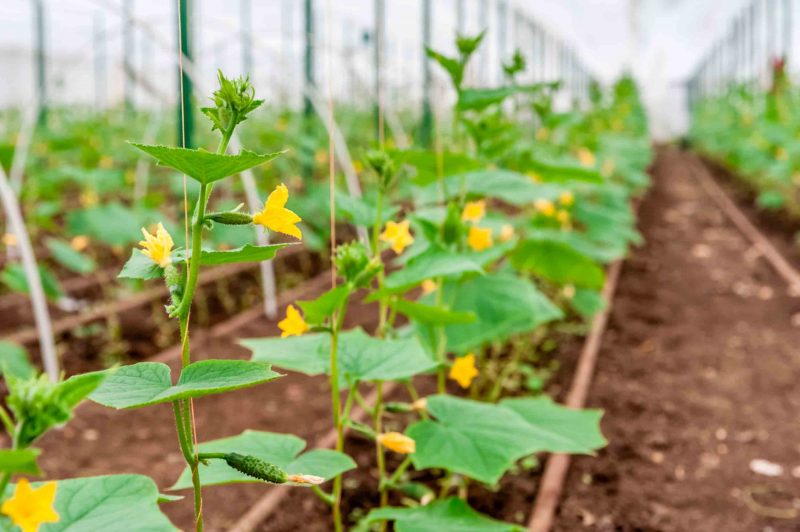
Cucumbers acquire a curved, arched shape - this is evidence of their cross pollination with non-hybrid varieties. Such fruits lose their characteristic and commercial qualities.
If the ovaries turn yellow and fall, the plant may not have enough nutrients to bear all the fruits.
Bitter cucumbers grow when a sharp drop in temperature and humidity occurs in the greenhouse during fruiting.
Diseases, pests and methods of dealing with them
Diseases of cucumbers in the greenhouse are divided into fungal, bacterial and caused by a lack of certain substances.
In some soils, they suffer from iron deficiency. The main symptom is the light color of the leaves. Eliminated by the introduction of iron chelate.

Often plants are affected by powdery mildew. The leaves in this disease are covered with a white coating resembling powder.
It is not easy to deal with it, especially with folk methods, so if you are serious, then immediately purchase special drugs:
- Topaz;
- Tiovit Jet;
- Bordeaux mixture.
To reduce the risk of powdery mildew, cucumbers need to be watered with not too cold water (18-25 degrees) and protected from sudden changes in temperature and humidity.
Less common is a bacterial disease - wet rot. Plants for no apparent reason begin to fade, a sticky mass appears on the stem, the leaves become stained. The disease is almost incurable. Productivity with it is reduced by 2 times. Seeds cannot be harvested from fruits from diseased plants. After harvesting, the whole leaves are burned, and no crops from the pumpkin family are sown on this place and in this greenhouse for 5 years.

Sometimes aphids attack cucumbers. These are small pale yellow insects, sucking juices from leaves. Fortunately, it is easily excreted by any insecticidal drugs.
How to prepare a greenhouse for winter?
At the end of the season, it is important to prepare the greenhouse for winter. After harvesting, the tops are removed and buried outside the greenhouse, or burned. The top layer of soil, with a depth of 10-15 cm, is removed, since it has been depleted during the season, and replaced with a new one, or they are waiting for spring to again prepare a warm bed. The soil surface for the prevention of fungal diseases can be sprayed with Fitosporin.
Film covers are dismantled. In most cases, the film by this time becomes unsuitable for use next year.
Cucumber is a thermophilic and in some places demanding culture. However, it remains one of the best suited for growing in greenhouses. If you approach this seriously, you can get a generous early harvest and even make good money on it!












